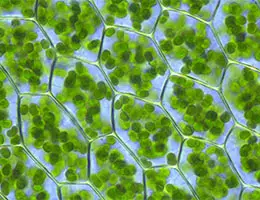 A chloroplast is an organelle present in plant cells , where photosynthesis takes place (the metabolic process that allows certain organisms to synthesize organic substances using sunlight as an energy source).
A chloroplast is an organelle present in plant cells , where photosynthesis takes place (the metabolic process that allows certain organisms to synthesize organic substances using sunlight as an energy source).
Delimited by two membranes, chloroplasts have vesicles called thylakoids that house molecules capable of transforming light energy from the sun's rays into chemical energy . One of these molecules is chlorophyll .
The outer membrane of the chloroplast has a good number of proteins called porins . In the inner membrane, however, the porins are smaller. Inside the chloroplast you can recognize the stroma , a cavity where carbon dioxide is fixed. Thylakoids, with chlorophyll, carotenoids and other pigments with photosynthetic capacity, are also found inside.
In the chloroplast it is also possible to recognize the plastoglobules , protected by a membrane that is similar to the one that covers the thylakoids, from which they are detached. Different organic molecules are found in plastoglobules, among which some lipids are especially common. It should be noted that not all the functions of the plastoglobule molecules have yet been specified.
Photosynthesis is carried out in two phases, each developed in different sectors of the chloroplast. The so-called light phase occurs in the membrane that surrounds the thylakoids, where the elements that convert light energy into chemical energy are found. The dark phase , for its part, is generated in the stroma. There an enzyme is responsible for fixing carbon dioxide.
The content of the cell is divided into various compartments and this phenomenon represents a challenge at an organizational level due to the concept known as protein trafficking , which, in a eukaryotic cell, regulates:
* classification signals , a reduced number of amino acids that form a compound known as a peptide , which in this case signals with lysosomal enzymes from the mannose-phosphate group the proteins that are secreted;
* the receptors that detect these signals and move the proteins in which they are contained to the relevant compartments.
The import of proteins through one or more external membranes that act as boundaries occurs in four cellular organelles: the chloroplast, the nucleus, the peroxisomes and the mitochondria . An example can be seen in the proteins that import these organelles into the rough endoplasmic reticulum, which have amino acid sequences that act as a “home” for the receptors located in the outer membrane to recognize them.
 While in the rough endoplasmic reticulum the import of proteins takes place almost contemporaneously with translation, in the other organelles it occurs after synthesis is completed in the free ribosomes of the cytoplasmic matrix (the so-called cytosol ). In the specific case of chloroplasts, proteins can reach a well-defined series of subcompartments: inner and outer envelope membranes; intermembranous space; stroma; thylakoid membrane; thylakoid light.
While in the rough endoplasmic reticulum the import of proteins takes place almost contemporaneously with translation, in the other organelles it occurs after synthesis is completed in the free ribosomes of the cytoplasmic matrix (the so-called cytosol ). In the specific case of chloroplasts, proteins can reach a well-defined series of subcompartments: inner and outer envelope membranes; intermembranous space; stroma; thylakoid membrane; thylakoid light.
The mechanisms used by the chloroplast to import proteins are very similar to those of the mitochondria, although the evolution of its translocations has been different.
It is important to mention that chloroplasts are present, beyond plants, in certain animals that acquire them through different processes, such as kleptoplasty , an endosymbiosis that consists of the plastids being assimilated by organisms that do not have them.
Kleptoplasty has the objective that the organisms that acquire the plastids can make use of their autotrophic capacity . This behavior has been observed in almost all sacoglossal mollusks and in certain dinoflagellates.
